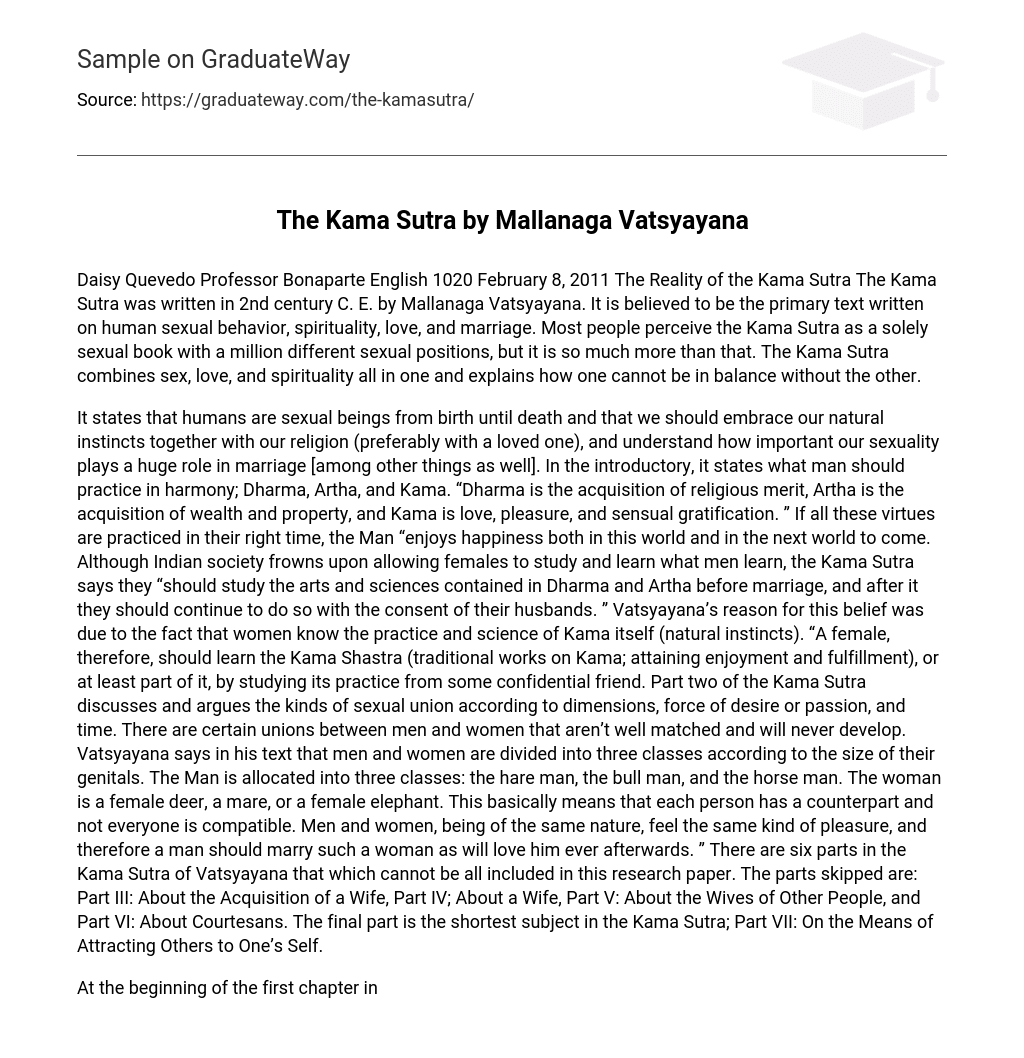The Kama Sutra, authored in the 2nd century C.E. by Mallanaga Vatsyayana, is a comprehensive text encompassing diverse aspects of human sexual behavior, spirituality, love, and marriage. Although commonly associated with sexual positions, it delves deeper into various areas. The Kama Sutra unifies sexuality, love, and spirituality to emphasize their interdependence in achieving balance.
The text emphasizes that humans are sexual beings throughout their entire lives and should embrace their natural desires along with their religion, preferably in the company of a loved one. It also highlights the significant role of sexuality in marriage and various other aspects. The introduction underscores the importance of practicing Dharma, Artha, and Kama harmoniously. Dharma refers to religious merit, Artha refers to wealth acquisition, and Kama represents love, pleasure, and sensual gratification. By practicing these virtues at the appropriate time, individuals can experience happiness in this life and the afterlife.
Despite the disapproval of Indian society towards female education, the Kama Sutra emphasizes that women should engage in learning the arts and sciences of Dharma and Artha before marriage. Even after marriage, with the consent of their husbands, women should continue to pursue these studies. The reason behind this belief, according to Vatsyayana, is that women possess knowledge of the practice and science of Kama (natural instincts). Therefore, it is important for females to acquire knowledge of Kama Shastra (traditional works on Kama) or at least learn some aspects of it through a trusted confidante.
The second part of the Kama Sutra delves into different types of sexual union, taking into account dimensions, intensity of desire or passion, and timing. Vatsyayana categorizes men and women based on their genital sizes to determine compatibility. Men are classified as hare man, bull man, or horse man, while women are classified as female deer, mare, or female elephant. This classification system implies that not all individuals are well-matched and able to thrive in a relationship.
When it comes to pleasure, both men and women with similar qualities have the same level of enjoyment. Hence, it is advisable for a man to find a lifelong partner who will continue loving him. The Kama Sutra of Vatsyayana consists of six sections: Part III: About the Acquisition of a Wife, Part IV: About a Wife, Part V: About the Wives of Other People, and Part VI: About Courtesans. These sections are not included in this research paper. The last section – Part VII: On the Means of Attracting Others to One’s Self – is relatively shorter compared to other topics.
In the opening chapter of Part VII, it is mentioned that if one fails to achieve their desires through previously discussed means in the Kama Sutra, alternative methods of charm should be pursued. Vatsyayana extensively covers the usage of tonic medicines, as well as herbs, plants, oils, animals, and other natural elements. These methods aim at enhancing attractiveness and appeal to the opposite gender, particularly for those who lack conventional attributes like beauty and youth.
Having read the Kama Sutra, I now possess a thorough comprehension of its main objective, which is to offer guidance on enhancing a man’s lingam (penis) and ensuring personal care and hygiene for women by providing techniques to enhance her yoni (vagina). Consequently, all my inquiries regarding this matter have been completely addressed. I strongly encourage those who lack knowledge in this subject to further explore it for their own enlightenment. However, it is important to acknowledge that due to its explicit content, the Kama Sutra should not be recommended to individuals below the legal age.
The marriage section of the book was complex, hindering my further exploration. To summarize, I wish to impart this wise and genuine quote to the reader: “This work is not solely for fulfilling our desires. One who comprehends the true principles of this science, adheres to righteousness, seeks material prosperity, and respects societal norms will unquestionably attain mastery over their senses.”





